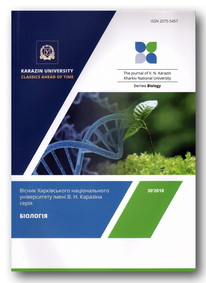Ecological preferences of the Swiss pine (Pinus cembra L.) forests in the Gorgany Nature Reserve
Abstract
Swiss pine (Pinus cembra L.) is a montane Carpathian (Alpine-Carpathian) species. The modern distribution of the Swiss pine is disjunct, the two isolated areas are located in western and central Europe (Alps) and the middle and high mountains of the Carpathians. The largest areas of Swiss pine in Ukraine are preserved in the Gorgany region at the altitude of 1250‒1450 m above sea level, where it forms the upper forest line. In the Gorgany Nature Reserve, P. cembra grows in the altitude range from 1070 to 1475 m ASL. The lower boundary, in the form of individual trees, descends to 1000 m ASL, and the upper boundary rises to 1585 m ASL. To define the ecological preferences of the Swiss pine, a series of route surveys were conducted and research sites (permanent forest monitoring plots, stationary research profiles, and stationary areas for the counting of natural forest regeneration) were established. The study of the plant communities with P. cembra on the southwestern slopes of the Dzhurdzhi tract showed the dependence of the forest species composition on the altitude above sea level. The forest stands quantitative composition and productivity are also significantly influenced by slope exposure. The proportion of P. cembra in the forests on steep slopes (30‒55°) of west and north-west exposure is relatively high (from 17.1% to 49.0%). Under other conditions, the proportion of P. cembra in the stand composition gradually decreases. Swiss pine is almost completely absent on the slopes of eastern and northern exposures except for rare single trees in Pinus mugo Turra scrub on northern slopes. The forests with P. cembra are typical of sunny slopes where the available sum of active temperatures ranges between 1000° and 1400° and the average ambient temperatures from -12.2°С to +16°С. The optimal environmental conditions for the relict species P. cembra in the Dovbushanski Gorgany region are on the western slopes with a steepness of 17‒55° and southwestern and northwestern slopes with a steepness of 35°‒42°. In terms of soil fertility, oligotrophic edaphotopes with moderate moisture are optimal for the growth of Swiss pine.
Downloads
References
Baitsar A.L. (2020). Geography of cedar forests of the Ukrainian Carpathians. http://baitsar.blogspot.com/2020/06/blog-post_26.html (in Ukrainian)
Golubets M.A., Gavrusevych A.N., Zagaikevich I.K. et al. (1988). Ukrainian Carpathian Mountains. Kyiv: Naukova Dumka. 300 p. (in Ukrainian)
Honcharenko I.V., Didukh Ya.P. (2003). The Brown-Blanquet method: history and modern trends. Scientific Notes NAUKMA: Ser. Biology and ecology, 21, 82–91. (in Ukrainian)
Didukh Ya.P. (2012). Fundamentals of bioindication. Kyiv: Naukova Dumka. 343 p. (in Ukrainian)
The Green Book of Ukraine. (2009). / Ed. Ya.P. Didukh. Kyiv: Alterpress. 448 p. (in Ukrainian)
Zrazhevskyi A.I. (1956). Natural occurrence of forest soil on stony placers and methods of their afforestation. Gruntoznavstvo, 10, 51–57. (in Ukrainian)
Oleksiv T.M., Klimuk Yu.V., Hlystiuk Yu.S. (2008). Monitoring of primeval forests with the participation of Pinus cembra L. in Dovbushanskyi Gorgani. Bulletin of Vasyl Stefanyk Prykarpattia National University. Series Biology, XII, 21–26. (in Ukrainian)
Oleksiv T.M., Klimuk Yu.V., Hlystiuk Yu.S. (2009). Ecology of the relict Pinus cembra L. in Dovbushanskyi Gorgani. Materials of the International scientific and practical conference dedicated to the 10th anniversary of the Rivne Nature Reserve (Sarny, June 11–13, 2009). Rivne: Rivne Printing House, 936. (in Ukrainian)
Popovych S.Yu., Mykhailovych N.V., Hrysyuk T.S. (2019). Representation of Pinus cembra (Pinaceae) in the nature reserve fund of Ukraine. Ukrainian Botanical Journal, 76(6), 534–541. https://doi.org/10.15407/ukrbotj76.06.533 (in Ukrainian)
Sirenko O.H. (2003). Ecological timeliness of stands with European cedar pine (Pinus cembra L.) in the Ukrainian Carpathians. Bulletin of Vasyl Stefanyk Prykarpatsky University. Series Biology, III, 13–25. (in Ukrainian)
Stoyko S.M. (1966). Nature reserves and monuments of the Ukrainian Carpathians. Lviv, 144. (in Ukrainian)
Red Book of Ukraine. Plant world. (2009). / Ed. Ya.P. Didukh. Kyiv: Globalconsulting. 900 p. (in Ukrainian)
Ali A.A., Carcaillet C., Talon B. et al. (2005). Terral Pinus cembra L. (arolla pine), a common tree in the inner French Alps since the early Holocene and above the present tree line: a synthesis based on charcoal data from soils and travertines. Journal of Biogeography, 32, 1659–1669. https://doi.org/10.1111/j.1365-2699.2005.01308.x
Bohoslavets O.M., Prydiuk M.P. (2023). New records of rare wood-inhabiting fungi from the Ukrainian Carpathians. Czech Mycology, 75(1), 61–83. https://doi.org/10.33585/cmy.75105
Casalegno S., Amatulli G., Camia A. et al. (2010). Vulnerability of Pinus cembra L. in the Alps and the Carpathian mountains under present and future climates. Forest Ecology and Management, 259, 750–761. https://doi.org/10.1016/j.foreco.2009.10.001
Farjon A. (2017). Pinus cembra. The IUCN Red List of Threatened Species 2017: e.T42349A95684563. http://dx.doi.org/10.2305/IUCN.UK.2017-2.RLTS.T42349A95684563.en
Ghadiriasli R., Mohamed A.A.M., Wagenstaller M. et al. (2020). Molecular and sensory characterization of odorants in Cembran pine (Pinus cembra L.) from different geographic regions. Talanta, 220, 121380. https://doi.org/10.1016/j.talanta.2020.121380
Hofmann A. (1970). L’areale italiano del pino cembro. Webbia, 25(1), 199–218. https://doi.org/10.1080/00837792.1970.10669934 (in Italian)
Kučera P. (2017). Two groups of Pinus cembra forest communities in the Tatras. Acta Botanica Hungarica 59(3–4), 389–425. https://doi.org/10.1556/034.59.2017.3-4.7
Mohytych V., Klisz M., Yatsyk R. et al. (2019). Ecological and genetic aspects of distribution of the marginal populations of Swiss stone pine (Pinus cembra L.) in Ukrainian Carpathians. Folia Forestalia Polonica, Series A – Forestry, 61(3), 242–246. https://doi.org/10.2478/ffp-2019-0023
Myczkowski S. (1971). Rozmieszenie: Limba Pinus cembra L. Nasze drzewa Leśne. Vol. II. (Ed. by S. Białobok) Warszawa, Poznań, Poland: PWN, 23–49. (in Polish)
Walter K.S., Gillett H.J. (1998). IUCN Red List of Threatened Plants. Compiled by the World Conservation Monitoring Centre. Switzerland and Cambridge (UK): IUCN – The World Conservation Union. 862 p.
Authors retain copyright of their work and grant the journal the right of its first publication under the terms of the Creative Commons Attribution License 4.0 International (CC BY 4.0), that allows others to share the work with an acknowledgement of the work's authorship.




